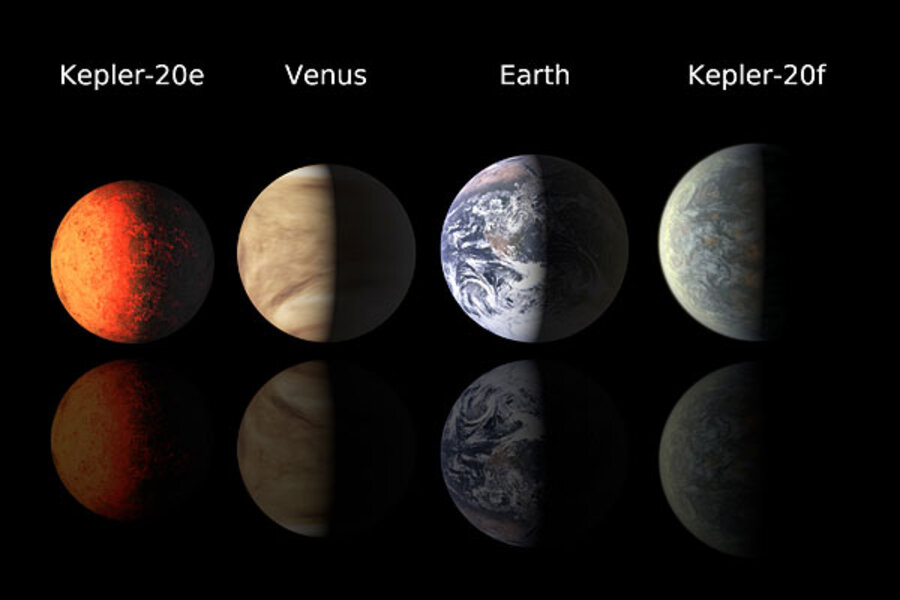First Earth-size planets found around distant star – in a bizarre solar system
Loading...
Scientists have found the first Earth-size planets orbiting a star like the sun, but the pair appear in a solar system so bizarre that it is for now upending current explanations for how solar systems form, the discoverers say.
The two planets, thought to be rocky, form a kind of cosmic triple-decker sandwich, with each interspersed among three Neptune-scale gas planets. All five are closer to their host star than Mercury is to the sun, meaning they are too hot for life.
But the find is proof that NASA's Kepler spacecraft can find Earth-size planets orbiting distant stars. Kepler 20e is slightly smaller than Venus, or about 0.87 times Earth's size. Kepler 20f is 1.03 times Earth's size.
Combined with the discovery, announced Dec. 5, of a "super Earth" in another star's habitable zone, these new planets move the Kepler team closer to its goal: detecting Earth-size planets in their stars' habitable zones – orbital distances where temperatures on the planet are warm enough to allow water to remain stable on the surface.
The newest discovery is "the most important milestone" for the Kepler team, says Francois Fressin, a researcher at the Harvard-Smithsonian Center for Astrophysics in Cambridge, Mass., and the lead author of the team's formal report, which is being published by the journal Nature.
Kepler uncovered the two Earth-size planets 1,000 light-years away by tracking the changes the brightness of light coming from their host star, Kepler 20, as the planets pass in front of it. Kepler 20e orbits its sun once every 6.1 days at an average distance of 4.7 million miles. Kepler 20f orbits once in 19.6 days at a distance of 10.3 million miles.
Earth, by contrast, is 93 million miles from the sun.
The team doesn't yet have an independent confirmation of the planets' masses, but given their sizes and orbits, the planets likely are rocky – probably composed of silicates and iron, as is Earth – according to current models of how solar systems form.
Yet the arrangement of the five planets orbiting Kepler 20 is calling those models into question. It could be dubbed the Neptune/Rocky Horror Picture Show.
The configuration of the five planets – Neptune-like planet, followed by small rocky planet, followed by Neptune-like planet, followed by small rocky planet, followed by Neptune-like planet – is decidedly unlike anything yet seen.
"The architecture of that planetary system is crazy," says David Charbonneau, another researcher from the Harvard-Smithsonian Center for Astrophysics and a Kepler team member.
From centuries of studying our own solar system, astronomers had pieced together a convincing picture of planet formation. Rocky planets formed close to the sun, where temperatures were too warm to allow gases and ices to accumulate. Meanwhile, gas and ice giants formed beyond the so-called snow line, where temperatures even on the sunward side of objects could not unfreeze water and allowed gases to condense into liquids.
"We thought all solar systems would be like this," says Linda Elkins-Tanton, who heads the Carnegie Institution for Science's Department of Terrestrial Magnetism in Washington.
Extrasolar-planet hunters then found so-called hot Jupiters – gas giants with Jupiter's mass and more – orbiting close to their parent stars. But that still could be explained: The giants just migrated inward and forced the smaller rocky planets into the star as they came, Dr. Elkins-Tanton suggests.
"Now, with this new Kepler finding, comes a solar system that doesn't fit any mold we have," she says. "This system forces us to change out ideas about how planets are formed, and how they reach stable orbits, and where indeed in solar systems there could be Earth-sized rocky planets."
The Kepler team's announcement Tuesday coincides with an additional report released the same day by scientist claiming to have found two planets smaller than Earth orbiting a relic of a red-giant star some 4,000 light-years away. Although this second group is not part of the Kepler team, they used Kepler data to make their discovery.





